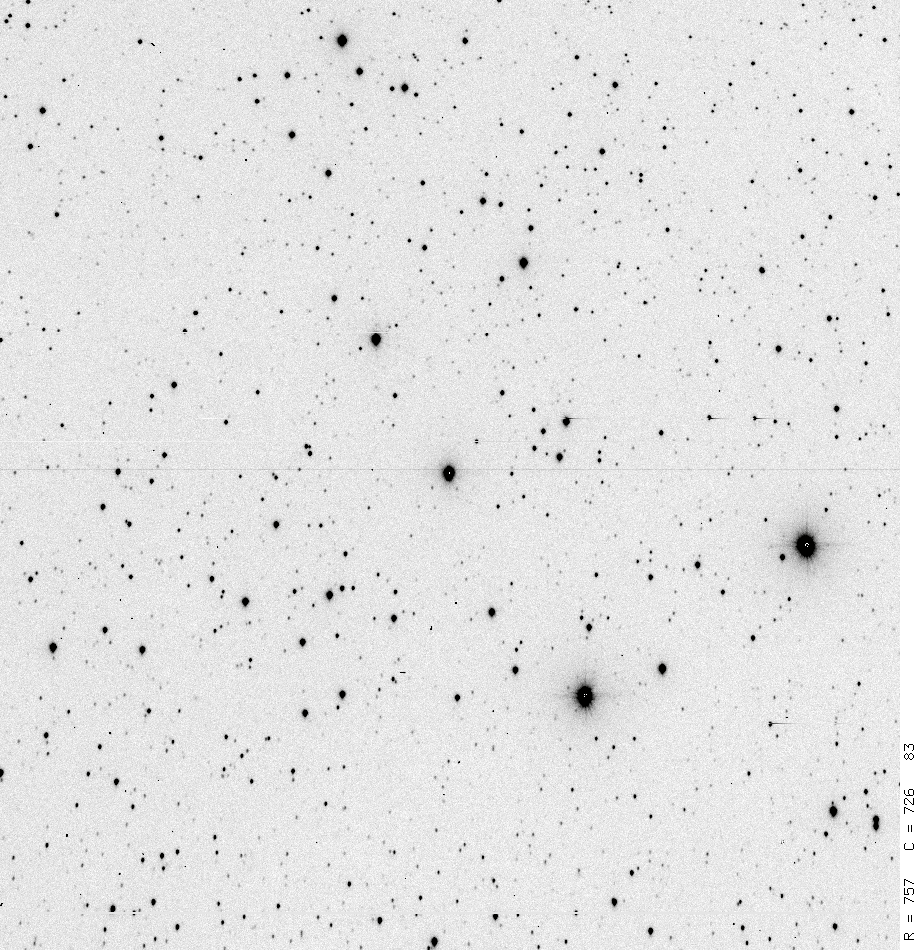
On the night of UT Jan 16, 2008, the SDSS Photometric Telescope ("PT" for short) took a series of exposures of XO-3. The conditions were fairly good, but we do not, I think, see a transit at the predicted time. I am puzzled by this.
Notes from the night
This is a chart of the field. XO-3 is the bright star indicated by the crosshairs. The labelled stars will appear in later analysis.

The host star of XO-3 has a magnitude V=9.80 according to XO-3b: A Massive Planet in an Eccentric Orbit Transiting an F5V Star.
Following the procedures outlined by Kent Honeycutt's article on inhomogeneous ensemble photometry, I used all stars available in each image to define a reference frame, and measured each star against this frame. You can find the software package used to do the ensemble photometry online; it's free!
The night was clear. The graph below shows the amount by which instrumental magnitudes from each image needed to be shifted to match the ensemble reference. On a clear night, this graph would show a straight horizontal line. Note the "bumpiness" early in the run, when I presume clouds passed overhead. I've discarded 4 or 5 images from this portion of the run already.

Below is a graph of the scatter in differential magnitude versus magnitude in the ensemble solution.

XO-3 is the star at differential mag 0.00; it shows a small excess of scatter over neighboring stars of the same brightness. The "noise floor" in these measurements is about 0.004 mag -- not bad, but not the best for the PT. The outlier at about differential mag 2.1 is the star labelled "X" in the chart above. Its light curve shows a brief dip of depth 0.5 mag and duration 0.015 days = 22 minutes; an eclipsing binary. A number of the other stars with higher than the usual scatter in this diagram are also eclipsing binaries.
Below are the light curves for the target (green symbols) and some comparison stars in the field. The black points show the light curve of star "X", one of several eclipsing binaries which are visible in the field.

In this closeup, I have shifted the data for three comparison stars to move them closer in magnitude to the target.

The green symbols do NOT show any transit, as far as I can see. The target star appears to increase slightly in the first half of the run, then decrease in the second half. The event predicted by the ephemeris in the discovery paper, and on transitsearch.org (see next paragraph) is shown for comparison.
An ephemeris grabbed from transitsearch.org predicts for this night
----------------------------------------------------------------------------------------
Begin Transit Window PREDICTED CENTRAL TRANSIT End Transit Window
All Times UT
HJD Year M D H M
2454481.73 2008 1 16 5 31 2454481.83 2008 1 16 7 55 2454481.93 2008 1 16 10 19
----------------------------------------------------------------------------------------
The ephemeris ingress of UT 2008 Jan 16 05:31:00 corresponds to JD 2,454,481.730. The ephemeris egress of UT 2008 Jan 16 10:19:00 corresponds to JD 2,454,481.930.
I don't know why we do not detect a dimming at the expected time. If I apply the uncertainties in the period and epoch of the transits provided in the discovery paper, the start and end of the transit should shift by only about 0.006 days at most. On the other hand, the most "transit-like" feature in the observed light curve might be an "ingress" starting around 481.83, which is 0.010 days later than the ephemeris. That seems shifted too far to be the transit ... or is it?
One reason that the photometry for XO-3 might be unreliable on this night is its unfortunate placement on top of a bad column on the PT chip, as this (rotated) image below shows. XO-3 is the bright star near the center of the frame; note the thin black line running through it. That's column number 734 in the corrected frame (if one starts counting at column 0).

You can grab the measurements for your own analysis. Below is a table with three flavors of time, plus the differential magnitude of the target and an estimate of the uncertainty in each measurement. I show the first few lines of the file to give you an idea of its format.
# Measurements of XO-3 made with APO PT, Jan 16, 2008 UT. # Each exposure 20 seconds long in SDSS i-band; # Tabulated times are midexposure (FITS header time - half exposure length) # and accurate only to +/- 1 second (??). # 'mag' is a differential magnitude based on ensemble photometry # using a circular aperture of radius 5.25 arcseconds. # # UT day JD-2,450,000 HJD-2,450,000 mag uncert Jan16.66227 4481.66227 4481.66575 -0.007 99.000 Jan16.66347 4481.66347 4481.66695 -0.004 99.000 Jan16.66473 4481.66473 4481.66821 -0.008 99.000 Jan16.66593 4481.66593 4481.66941 -0.002 99.000
Last modified 01/31/2008 by MWR.